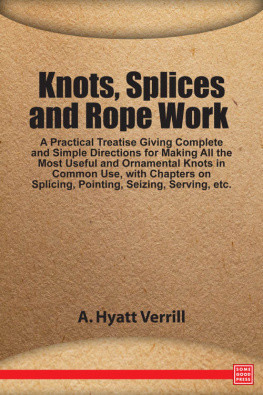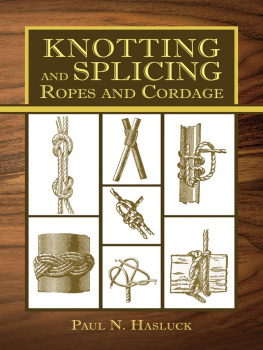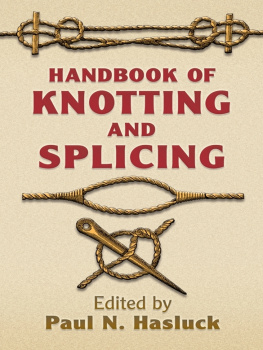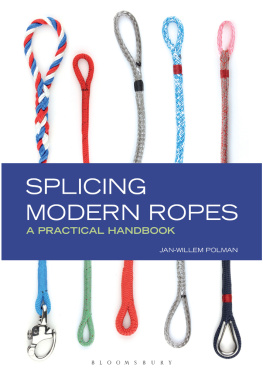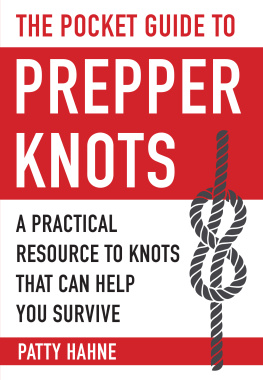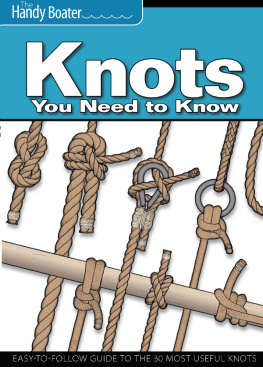KNOTS, SPLICES and ROPE WORK
A PRACTICAL TREATISE
Giving Complete and Simple Directions for Making All the Most Useful and Ornamental Knots in Common Use, with Chapters on Splicing, Pointing, Seizing, Serving, etc. Adapted for the Use of Travellers, Campers, Yachtsmen, Boy Scouts, and All Others Having to Use or Handle Ropes for Any Purpose.
By
A. HYATT VERRILL
Editor Popular Science Dept., "American Boy Magazine."
SECOND REVISED EDITION
Illustrated with 156 Original Cuts Showing How
Each Knot, Tie or Splice is Formed and Its
Appearance When Complete.
INTRODUCTION
The history of ropes and knots is so dim and ancient that really little is known of their origin. That earliest man used cordage of some kind and by his ingenuity succeeded in tying the material together, is indisputable, for the most ancient carvings and decorations of prehistoric man show knots in several forms. Doubtless the trailing vines and plants first suggested ropes to human beings; and it is quite probable that these same vines, in their various twistings and twinings, gave man his first idea of knots.
Since the earliest times knots have been everywhere interwoven with human affairs; jugglers have used them in their tricks; they have become almost a part of many occupations and trades, while in song and story they have become the symbol of steadfastness and strength.
Few realize the importance that knots and cordage have played in the world's history, but if it had not been for these simple and every-day things, which as a rule are given far too little consideration, the human race could never have developed beyond savages. Indeed, I am not sure but it would be safe to state that the real difference between civilized and savage man consists largely in the knowledge of knots and rope work. No cloth could be woven, no net or seine knitted, no bow strung and no craft sailed on lake or sea without numerous knots and proper lines or ropes; and Columbus himself would have been far more handicapped without knots than without a compass.
History abounds with mention of knots, and in the eighth book of "Odyssey" Ulysses is represented as securing various articles of raiment by a rope fastened in a "knot closed with Circean art"; and as further proof of the prominence the ancients gave to knots the famous Gordian Knot may be mentioned. Probably no one will ever learn just how this fabulous knot was tied, and like many modern knots it was doubtless far easier for Alexander to cut it than to untie it.
The old sorcerers used knots in various ways, and the witches of Lapland sold sailors so-called "Wind Knots," which were untied by the sailors when they desired a particular wind. Even modern conjurors and wizards use knots extensively in their exhibitions and upon the accuracy and manner in which their knots are tied depends the success of their tricks.
In heraldry many knots have been used as symbols and badges and many old Coats of Arms bear intricate and handsome knots, or entwined ropes, emblazoned upon them.
As to the utility of knots and rope work there can be no question. A little knowledge of knots has saved many a life in storm and wreck, and if every one knew how to quickly and securely tie a knot there would be far fewer casualties in hotel and similar fires. In a thousand ways and times a knowledge of rope and knots is useful and many times necessary. Many an accident has occurred through a knot or splice being improperly formed, and even in tying an ordinary bundle or "roping" a trunk or box few people tie a knot that is secure and yet readily undone and quickly made. In a life of travel and adventure in out-of-the-way places, in yachting or boating, in hunting or fishing, and even in motoring, to command a number of good knots and splices is to make life safer, easier, and more enjoyable, aside from the real pleasure one may find in learning the interesting art of knot-tying.
Through countless ages the various forms of knots and fastenings for rope, cable, or cord have been developed; the best kinds being steadily improved and handed down from generation to generation, while the poor or inferior fastenings have been discarded by those whose callings required the use of cordage.
Gradually, too, each profession or trade has adopted the knots best suited to its requirements, and thus we find the Sailor's Knot; the Weaver's Knot; Fishermen's knots; Builders' knots; Butchers' knots; and many others which have taken their names from the use to which they are especially adapted.
In addition to these useful knots, there are many kinds of ornamental or fancy knots used in ornamenting the ends of ropes, decorating shrouds of vessels, railings, and similar objects; while certain braids or plaits, formed by a series of knots, are widely used aboard ship and on land.
In many cases ropes or cable must be joined in such a way that they present a smooth and even surface and for such purposes splices are used, while knots used merely as temporary fastenings and which must be readily and quickly tied and untied are commonly known as "bends" or "hitches." Oddly enough, it is far easier to tie a poor knot than a good one, and in ninety-nine cases out of a hundred the tyro, when attempting to join two ropes together, will tie either a "slippery" or a "jamming" knot and will seldom succeed in making a recognized and "ship-shape" knot of any sort.
The number of knots, ties, bends, hitches, splices, and shortenings in use is almost unlimited and they are most confusing and bewildering to the uninitiated. The most useful and ornamental, as well as the most reliable, are comparatively few in number, and in reality each knot learned leads readily to another; in the following pages I have endeavored to describe them in such a manner that their construction may be readily understood and mastered.
THE AUTHOR.
JANUARY, 1917.
CHAPTER I
CORDAGE
Before taking up the matter of knots and splices in detail it may be well to give attention to cordage in general. Cordage, in its broadest sense, includes all forms and kinds of rope, string, twine, cable, etc., formed of braided or twisted strands.

In making a rope or line the fibres (A, Fig. 1) of hemp, jute, cotton, or other material are loosely twisted together to form what is technically known as a "yarn" (B, Fig. 1). When two or more yarns are twisted together they form a "strand" (C, Fig. 1). Three or more strands form a rope (D, Fig. 1), and three ropes form a cable (E, Fig. 1). To form a strand the yarns are twisted together in the opposite direction from that in which the original fibres were twisted; to form a rope the strands are twisted in the opposite direction from the yarns of the strands, and to form a cable each rope is twisted opposite from the twist of the strands. In this way the natural tendency for each yarn, strand, or rope to untwist serves to bind or hold the whole firmly together (Fig. 1).

Rope is usually three-stranded and the strands turn from left to right or "with the sun," while cable is left-handed or twisted "against the sun" (E, Fig. 1). Certain ropes, such as "bolt-rope" and most cables, are laid around a "core" (F, Fig. 2) or central strand and in many cases are four-stranded (Fig. 2).
The strength of a rope depends largely upon the strength and length of the fibres from which it is made, but the amount each yarn and strand is twisted, as well as the method used in bleaching or preparing the fibres, has much to do with the strength of the finished line.
Next page
